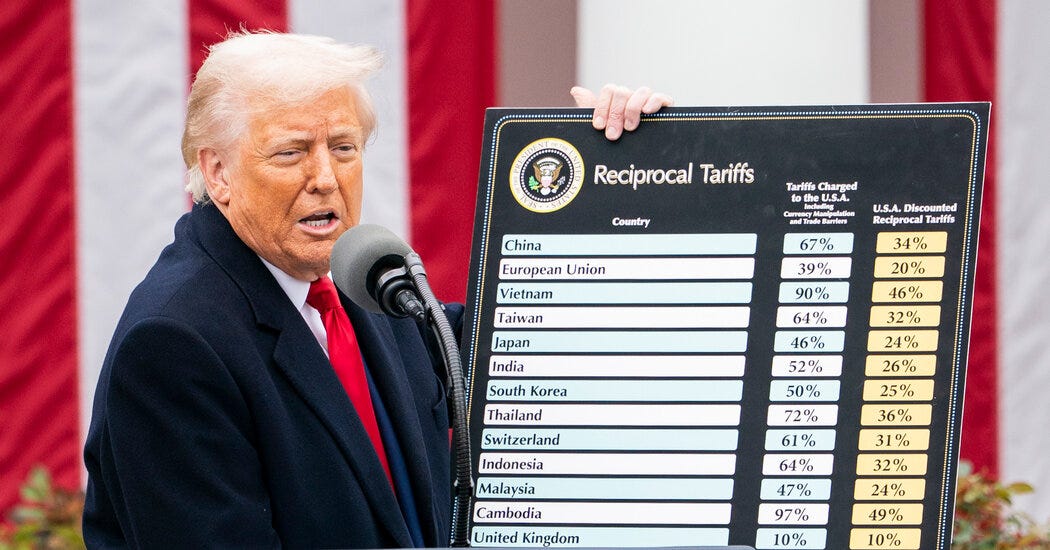The Tariffs Will Likely Shrink the American Economy
There is a reason why tariffs are rarely supported by economists, progressive or conservative
Back in October, I had written an article on the debate surrounding tariffs in the 2024 United States Presidential Election. Well, since then, Donald Trump won the election and was sworn in as President. He has since enacted an aggressive version of his tariff policy, with a recent “liberation day” tariff announcement, where he enacted a flat 10% tariff and tariffs on countries with which the United States has a trade deficit. This has since led to a large-scale stock market crash, while being the most aggressive tariff placed by the United States since 1930’s Smoot-Hawley Tariff.
A reminder that I am a sophomore student of economics. A lot of economic theory is intensely debated to this very day, and I am only explaining the little I know in simple terms.
Today, I am going to focus on marcroeconomic consequences of these tariffs. I will not focus on the stock market, as it is a completely separate can of worms, and I don’t want to make this article too long. However, if there is interest, I could make a follow up article focusing on the stock market consequences of such a decision.
To briefly define a tariff, a tariff is a tax on foreign imports or exports. Typically, the goal of tariffs is to strengthen domestic industry against foreign competition. However, their efficiency is criticized by many free trade advocates.
Free trade’s criticisms of tariffs are based on the principle of comparative advantage. The principle states that every country or region can specialize in particular types of goods or services depending on their available land, labor, and capital. They can then trade these goods with other countries and achieve more goods. Effectively, free trade turns what you have into what you want, allowing everyone to get more of everything.
This principle (of comparative advantage) was the creation of economist David Ricardo back in the early 1800s, and has since been the dominant global economic philosophy. In 1944, in reaction to high tariff rates, GATT, the predecessor to the WTO, was created to lower tariff rates. From 1944 to 2025, tariff rates have largely stayed at historic lows.
Meanwhile, critics of free trade point out that while free trade has led to net growth in jobs, the gains haven’t been even and inequality has increased. Other criticisms state that free trade is used as a neocolonial tool to maintain power over foreign countries. That said, free trade is associated with a global decrease in poverty and mortality rates.
President Trump’s new tariffs have seen criticism from free trade advocates across the aisle. Rather than just attack the United States’ historic enemies with these tariffs, his administration has targeted most countries with which the United States has a trade deficit with.
However, the United States’ trade deficit has had a historic purpose. The United States’ trade deficit has served as a tool of spreading US Dollars (USD) across the world, allowing the USD to maintain its place as the world’s reserve currency. A trade deficit means that the United States has an investment surplus, after all.
Of course, there are potential costs associated with becoming a country with large trade deficits, but its important to remember that every decision has consequences.
Questions have also been raised in terms of the effectiveness of tariffs as a potential negotiating tool. So far, nearly every major increase in tariff rates over the past hundred years has been associated with reciprocal increases in tariff rates. Of course, the Trump administration has suggested that the reason for these tariffs is to target countries placing tariffs on the United States, but the rates seem to be targeting nations with trade surpluses with the United States.
The principles of individual tariff rates per country break the rule of Most Favored Nation (MFN), which states that a nation should place the same protectionism rates on all nations within a group, which is followed by the World Trade Organization and theoretically by all its nations. However, the WTO has not had adjourning judges since 2021, leaving the organization on ice, and the principle of Most Favored Nation effectively dead.
There is a legitimate argument for reciprocal tariffs and dealing with protectionism placed by foreign countries, particularly China. However, a blanket tariff targeting trade deficits will only end up weakening the United States’ standing internationally, and potentially lead to recession and inflation within the United States (known by the terrifyingly bizarre term – “Stagflation”).
Even the economists that the White House has quoted to explain their tariff rates have criticized the particulars of Trump’s tariff deal. Even if the goal was to reduce the United States’ trade deficit, a blanket rate determined by existing trade deficits is unlikely to lower the trade deficit (even if that was a good goal), as individual nations will just reduce trade with the United States, rather than balancing imports and exports.
Of course, everyone is entitled to their own perspectives, and perhaps I could be wrong on the tariffs. Economics is a soft science, relying more on human behavior than universal rules. However, economic history is clearly against such a tariff raise.


